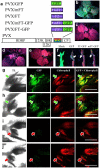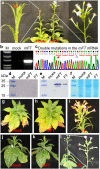Mobile FT mRNA contributes to the systemic florigen signalling in floral induction
- PMID: 22355592
- PMCID: PMC3216560
- DOI: 10.1038/srep00073
Mobile FT mRNA contributes to the systemic florigen signalling in floral induction
Abstract
In inducing photoperiodic conditions, plants produce a signal dubbed "florigen" in leaves. Florigen moves through the phloem to the shoot apical meristem (SAM) where it induces flowering. In Arabidopsis, the FLOWERING LOCUS T (FT) protein acts as a component of this phloem-mobile signal. However whether the transportable FT mRNA also contributes to systemic florigen signalling remains to be elucidated. Using non-conventional approaches that exploit virus-induced RNA silencing and meristem exclusion of virus infection, we demonstrated that the ArabidopsisFT mRNA, independent of the FT protein, can move into the SAM. Viral ectopic expression of a non-translatable FT mRNA promoted earlier flowering in the short-day (SD) Nicotiana tabacum Maryland Mammoth tobacco in SD. These data suggest a possible role for FT mRNA in systemic floral signalling, and also demonstrate that cis-transportation of cellular mRNA into SAM and meristem exclusion of pathogenic RNAs are two mechanistically distinct processes.
Figures





Similar articles
-
Leaf-produced floral signals.Curr Opin Plant Biol. 2008 Oct;11(5):541-7. doi: 10.1016/j.pbi.2008.06.009. Epub 2008 Aug 6. Curr Opin Plant Biol. 2008. PMID: 18691931 Review.
-
A cis element within flowering locus T mRNA determines its mobility and facilitates trafficking of heterologous viral RNA.J Virol. 2009 Apr;83(8):3540-8. doi: 10.1128/JVI.02346-08. Epub 2009 Feb 4. J Virol. 2009. PMID: 19193810 Free PMC article.
-
FTIP1 is an essential regulator required for florigen transport.PLoS Biol. 2012;10(4):e1001313. doi: 10.1371/journal.pbio.1001313. Epub 2012 Apr 17. PLoS Biol. 2012. PMID: 22529749 Free PMC article.
-
The bZIP transcription factor AREB3 mediates FT signalling and floral transition at the Arabidopsis shoot apical meristem.PLoS Genet. 2023 May 15;19(5):e1010766. doi: 10.1371/journal.pgen.1010766. eCollection 2023 May. PLoS Genet. 2023. PMID: 37186640 Free PMC article.
-
Regulation and identity of florigen: FLOWERING LOCUS T moves center stage.Annu Rev Plant Biol. 2008;59:573-94. doi: 10.1146/annurev.arplant.59.032607.092755. Annu Rev Plant Biol. 2008. PMID: 18444908 Review.
Cited by
-
A critical appraisal of phloem-mobile signals involved in tuber induction.Front Plant Sci. 2013 Jul 16;4:253. doi: 10.3389/fpls.2013.00253. eCollection 2013. Front Plant Sci. 2013. PMID: 23882274 Free PMC article.
-
Systemic signaling contributes to the unfolded protein response of the plant endoplasmic reticulum.Nat Commun. 2018 Sep 25;9(1):3918. doi: 10.1038/s41467-018-06289-9. Nat Commun. 2018. PMID: 30254194 Free PMC article.
-
Long-Distance Movement of mRNAs in Plants.Plants (Basel). 2020 Jun 10;9(6):731. doi: 10.3390/plants9060731. Plants (Basel). 2020. PMID: 32531920 Free PMC article. Review.
-
A Composite Analysis of Flowering Time Regulation in Lettuce.Front Plant Sci. 2021 Mar 8;12:632708. doi: 10.3389/fpls.2021.632708. eCollection 2021. Front Plant Sci. 2021. PMID: 33763095 Free PMC article.
-
VipariNama: RNA viral vectors to rapidly elucidate the relationship between gene expression and phenotype.Plant Physiol. 2021 Aug 3;186(4):2222-2238. doi: 10.1093/plphys/kiab197. Plant Physiol. 2021. PMID: 34009393 Free PMC article.
References
-
- Zeevaart J. A. D. Physiology of flower formation. Annu. Rev. Plant Physiol. 27, 321–348 (1976).
-
- Corbesier L. & Coupland G. The quest for florigen: a review of recent progress. J. Exp. Bot. 57, 3395–3403 (2006). - PubMed
-
- Abe M. et al.. FD, a bZIP protein mediating signals from the floral pathway integrator FT at the shoot apex. Science 309, 1052–1056 (2005). - PubMed
-
- An H. et al.. CONSTANS acts in the phloem to regulate a systemic signal that induces photoperiodic flowering of Arabidopsis. Development 131, 3615–3526 (2004). - PubMed
Publication types
MeSH terms
Substances
Grants and funding
LinkOut - more resources
Full Text Sources
Other Literature Sources
Molecular Biology Databases

